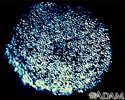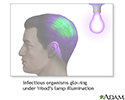Wood's lamp examination
Black light test; Ultraviolet light test
A Wood's lamp examination is a test that uses ultraviolet (UV) light to look at the skin closely.
How the Test is Performed
You sit in a dark room for this test. The test is usually done in a skin doctor's (dermatologist) office. The doctor will turn on the Wood's lamp and hold it 4 to 5 inches (10 to 12.5 centimeters) from the skin to look for color changes.
How to Prepare for the Test
You do not need to take any special steps before this test. Follow your doctor's instructions about not putting creams or medicines on the area of the skin before the test.
How the Test will Feel
You will have no discomfort during this test.
Why the Test is Performed
This test is done to look for skin problems including:
- Bacterial infections
- Fungal infections
-
Porphyria
Porphyria
Porphyrias are a group of rare inherited disorders. An important part of hemoglobin, called heme, is not made properly. Heme is also found in myogl...
 ImageRead Article Now Book Mark Article
ImageRead Article Now Book Mark Article - Skin coloring changes, such as vitiligo
Not all types of bacteria and fungi show up under the light.
Normal Results
Normally the skin will not shine under the ultraviolet light.
What Abnormal Results Mean
A Wood's lamp exam may help your doctor confirm a fungal infection or bacterial infection. Your doctor may also be able to learn what is causing any light- or dark-colored spots on your skin.
Fungal infection
Ringworm of the scalp is a fungal infection that affects the scalp. It is also called tinea capitis. Related ringworm infections may be found:In a m...

The following things can change the results of the test:
- Washing your skin before the test (may cause a false-negative result)
- A room that is not dark enough
- Other materials that glow under the light, such as some deodorants, make-ups, soaps, and sometimes lint
Risks
There are no risks with this test. DO NOT look directly into the ultraviolet light.
References
Gebhard RE. Wood's light examination. In: Pfenninger JL, Fowler GC, eds. Pfenninger & Fowler's Procedures for Primary Care . 3rd ed. Philadelphia, PA: Elsevier Mosby; 2010:chap 43.
Ruocco E, Baroni A, Donnarumma G, Ruocco V. Diagnostic procedures in dermatology. Clin Dermatol . 2011;29:548-56. PMID 21855731 www.ncbi.nlm.nih.gov/pubmed/21855731 .
-
Wood's lamp test - of the scalp - illustration
A Wood's lamp is a light that uses long wave ultraviolet light. When an area of scalp that is infected with tinea (a type of ringworm fungus) is viewed under a Wood's light, the fungus may glow. This test may be done to detect the presence of a fungal scalp or skin infection.
Wood's lamp test - of the scalp
illustration
-
Wood's lamp illumination - illustration
A Wood's lamp emits ultraviolet light and can be a diagnostic aid in determining if someone has a fungal or bacterial infection on the skin or scalp. If there is an infection on the area where the Wood's lamp is illuminating, the area will fluoresce. Normally the skin does not fluoresce, or shine, under ultraviolet light.
Wood's lamp illumination
illustration
-
Wood's lamp test - of the scalp - illustration
A Wood's lamp is a light that uses long wave ultraviolet light. When an area of scalp that is infected with tinea (a type of ringworm fungus) is viewed under a Wood's light, the fungus may glow. This test may be done to detect the presence of a fungal scalp or skin infection.
Wood's lamp test - of the scalp
illustration
-
Wood's lamp illumination - illustration
A Wood's lamp emits ultraviolet light and can be a diagnostic aid in determining if someone has a fungal or bacterial infection on the skin or scalp. If there is an infection on the area where the Wood's lamp is illuminating, the area will fluoresce. Normally the skin does not fluoresce, or shine, under ultraviolet light.
Wood's lamp illumination
illustration
Review Date: 12/2/2014
Reviewed By: Richard J. Moskowitz, MD, Dermatologist in Private Practice, Mineola, NY. Review provided by VeriMed Healthcare Network. Also reviewed by David Zieve, MD, MHA, Isla Ogilvie, PhD, and the A.D.A.M. Editorial team.


